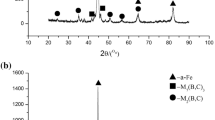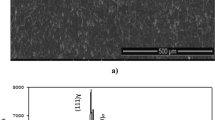Abstract
There is a need to investigate a novel non-traditional surface hardening procedure for heat-resistant steel micro-alloyed with boron. In this research, boron powder pack processing was employed. Steel samples were boronized and mechanically investigated using hardness, three-point bending, and wear tests. Scanning electron microscopes and EDX were used to examine the microstructure before and after boronization. Boron was added in the form of a 50/50 combination of borax and boric acid in a crucible inside an induction furnace at 1050 °C for 30 min. The application of borax and boric acid 50/50 increased flexural strength from 614 to 1526 MPa and a further increase to 1700 MPa is achieved when ammonia bicarbonate (25%) with borax and boric acid 50/50 (75%) were used. The combination of ultra-fast boronizing and ammonia causes both surface and bulk hardening, which increases flexural strength. The produced steels are suitable for thermal and neutron shielding.






Similar content being viewed by others
Explore related subjects
Discover the latest articles, news and stories from top researchers in related subjects.Data availability
Due to the sensitive nature of the data and privacy concerns, we regret to inform you that the datasets used in our research are not available for external sharing or public dissemination. The data are safeguarded to ensure the privacy and confidentiality of the individuals and entities involved in the study. We assure the editorial team that the unavailability of the data does not compromise the integrity of our research findings presented in the manuscript. We remain committed to upholding the highest standards of research ethics and compliance with relevant regulations.
References
Taylor T et al (2014) New generation ultrahigh strength boron steel for automotive hot stamping technologies. Mater Sci Technol 30(7):818–826. https://doi.org/10.1179/1743284713Y.0000000409
Liu Q et al (2016) A review of the influence of hydrogen on the mechanical properties of DP, TRIP, and TWIP advanced high-strength steels for auto construction. Corros Rev 34(3):127–152. https://doi.org/10.1515/corrrev-2015-0083
Tishkevich DI, Rotkovich AA, German SA, Zhaludkevich AL, Vershinina TN, Bondaruk AA, Razanau IU, Dong M, Sayyed MI, Leonchik SV, Zubar T, Silibin MV, Trukhanov SV, Trukhanov AV (2023) Heavy alloy based on tungsten and bismuth: fabrication, crystal structure, morphology, and shielding efficiency against gamma-radiation. RSC Adv 13:24491–24498. https://doi.org/10.1039/d3ra04509a
Khan SA, Ali I, Hussain A, Javed HMA, Turchenko VA, Trukhanov AV, Trukhanov SV (2022) Synthesis and characterization of composites with Y-hexaferrites for electromagnetic interference shielding applications. Magnetochem 8:186. https://doi.org/10.3390/magnetochemistry8120186
Shpylka DO, Ovsiienko IV, Len TA, Matzui LYu, Trukhanov SV, Trukhanov AV, Yakovenko OS (2022) The features of the magnetoresistance of carbon nanotubes modified with Fe. Ceram Int 48:19789–19797. https://doi.org/10.1016/j.ceramint.2022.03.253
Abe F (2008) Precipitate design for creep strengthening of 9% Cr tempered martensitic steel for ultra-supercritical power plants. Sci Technol Adv Mater 9(1):013002. https://doi.org/10.1088/1468-6996/9/1/013002
Shibuya M, Toda Y, Sawada K, Kushima H, Kimura K (2016) Improving the high-temperature creep strength of 15Cr creep-resistant steels at temperatures of 923–1023 K. Mater Sci Eng A 652:1–6. https://doi.org/10.1016/j.msea.2015.11.068
Abe F (2009) Analysis of creep rates of tempered martensitic 9% Cr steel based on microstructure evolution. Mater Sci Eng A 510:64–69. https://doi.org/10.1016/j.msea.2008.04.118
Abe F, Horiuchi T, Taneike M, Sawada K (2004) Stabilization of martensitic microstructure in advanced 9Cr steel during creep at high temperature. Mater Sci Eng A 378(1–2):299–303. https://doi.org/10.1016/j.msea.2003.11.073
Trukhanov SV, Trukhanov AV, Turchenko VA, An V, Trukhanov EL, Trukhanova DI, Tishkevich VM, Ivanov TI, Zubar M, Salem VG, Kostishyn LV, Panina DA, Vinnik SAG (2018) Polarization origin and iron positions in indium doped barium hexaferrites. Ceram Int 44:290–300. https://doi.org/10.1016/j.ceramint.2017.09.172
Almessiere MA, Slimani Y, Baykal A, Gungunes H, Caliskan S, Vakhitov MG, Klygach DS, Zubar TI, Trukhanov SV, Trukhanov AV, Ul-Hamid A (2023) Impact of Sc3+/In3+ions co-substitution on structural, magnetic, and microwave features of SrFe12O19 hexaferrites. J Alloys Compd 968:172197. https://doi.org/10.1016/j.jallcom.2023.172197
El-Shater RE, El Shimy H, Saafan SA, Darwish MA, Zhou D, Naidu KCB, Khandaker MU, Mahmoud Z, Trukhanov AV, Trukhanov SV, Fakhry F (2023) Fabrication of doped ferrites and exploration of its structure and magnetic behavior. Mater Adv 4:2794–2810. https://doi.org/10.1039/d3ma00105a
Kotelnikova A, Zubar T, Vershinina T, Panasiuk M, Kanafyev O, Fedkin V, Kubasov I, Turutin A, Trukhanov S, Tishkevich D, Fedosyuk V, Trukhanov A (2022) Saccharin adsorption influence on the NiFe alloy films growth mechanisms during electrodeposition. RSC Adv 12:35722–35729. https://doi.org/10.1039/D2RA07118E
Calik A, Ucar N, Yeniay N (2022) A study of boronizing kinetics and its effect on the structure and mechanical properties of steel 16MnCr5. Met Sci Heat Treat 64:63–68. https://doi.org/10.1007/s11041-022-00762-5
Shibata K (2003) Behavior of boron in steels and its effect on properties. Tetsu-to-hagané 89(3):62
Rabeeh BM (2015) Ultra-fast boriding and surface hardening of low carbon steel. TMS 2015 144th annual meeting & exhibition. Springer, Cham. https://doi.org/10.1007/978-3-319-48127-2_178
Golberg D et al (2007) Boron nitride nanotubes. Adv Mater 19(18):2413–2432. https://doi.org/10.1002/adma.200700179
Sen U, Sen S, Yilmaz F (2004) An evaluation of some properties of borides deposited on boronized ductile iron. J Mater Process Technol 148(1):1–7. https://doi.org/10.1016/j.jmatprotec.2004.01.015
Kalay S, Yilmaz Z, Sen O, Emanet M, Kazanc E, Çulha M (2015) Synthesis of boron nitride nanotubes and their applications. Beilstein J Nanotechnol 6(1):84–102. https://doi.org/10.3762/bjnano.6.9
Shi L, Wang D, LU A-H (2018) A viewpoint on catalytic origin of boron nitride in oxidative dehydrogenation of light alkanes. Chin J Catal 39(5):908–913. https://doi.org/10.1016/S1872-2067(18)63060-8
Kulka M (2019) Current trends in boriding. Springer International Publishing, Cham. https://doi.org/10.1007/978-3-030-06782-3_3
Celikyurek İ et al (2006) Boronizing of iron aluminide Fe72Al28. Intermetallics 14(2):136–141. https://doi.org/10.1016/j.intermet.2005.04.018
Ozdemir O et al (2008) An investigation on boriding kinetics of AISI 316 stainless steel. Vacuum 83(1):175–179. https://doi.org/10.1016/j.vacuum.2008.03.026
Taktak S (2007) Some mechanical properties of borided AISI H13 and 304 steels. Mater Des 28(6):1836–1843. https://doi.org/10.1016/j.matdes.2006.04.017
Trukhanov SV (2011) Peculiarities of magnetic phase separation in anion-deficient La0.70Sr0.30MnO2.85 manganite. Phys Solid State 53:1845–1850. https://doi.org/10.1134/s1063783411090307
El-Kashif E, Asakura K, Shibata K (2002) Effects of nitrogen in heat resistant steels containing boron. ISIJ Int 42(12):1468–1476. https://doi.org/10.2355/isijinternational.42.1468
Trukhanov SV, Fedotova VV, Trukhanov AV, Stepin SG, Szymczak H (2008) Synthesis and structure of nanocrystalline La0.50Ba0.50MnO3. Crystallogr Rep 53:1177–1180. https://doi.org/10.1134/S1063774508070158
Yan P, Liu Z, Bao H, Weng Y, Liu W (2013) Effect of microstructural evolution on high-temperature strength of 9Cr–3W–3Co martensitic heat resistant steel under different aging conditions. Mater Sci Eng A 588:22–28
Yan P, Liu Z, Bao H, Weng Y, Liu W (2014) Effect of normalizing temperature on the strength of 9Cr–3W–3Co martensitic heat resistant steel. Mater Sci Eng A 597:148–156
Hkdh B (2001) Design of creep-resistant steels. ISIJ Int 41(6):626–640. https://doi.org/10.2355/isijinternational.41.626
Erden MA et al (2017) Effect of boron nitride addition on the microstructure and mechanical properties of PM steels. Afyon Kocatepe Üniversitesi Fen Ve Mühendislik Bilimleri Dergisi 17(1):185–191
Galiotto A et al (2019) Characterization of different surface layers produced by solid boron-nitro-carburizing thermochemical treatment on AISI 1020. Mater Res. https://doi.org/10.1590/1980-5373-MR-2019-0316
Ninpetch P et al (2018) Effect of boron nitride on microstructure of Fe-Cr-Mo-BN-C steel sintered in vacuum. Mater Today Proc 5(3):9409–9416. https://doi.org/10.1016/j.matpr.2017.10.118
Łukaszewicz G et al (2023) Effect of prior boriding on microstructure and mechanical properties of nanobainitic X37CrMoV5–1 hot-work tool steel. Materials 16(12):4237. https://doi.org/10.3390/ma16124237
Mukhacheva TL, Kalinina TM, Kusmanov SA (2021) Evaluation of tribotechnical properties of modified surfaces after plasma electrolytic treatment. J Phys Conf Ser 2144:012031. https://doi.org/10.1088/1742-6596/2144/1/012031
Balusamy T et al (2013) Effect of surface mechanical attrition treatment (SMAT) on pack boronizing of AISI 304 stainless steel. Surf Coat Technol 232:60–67. https://doi.org/10.1016/j.surfcoat.2013.04.053
Campos-Silva I et al (2018) Effects of scratch tests on the adhesive and cohesive properties of borided Inconel 718 superalloy. Surf Coat Technol 349:917–927. https://doi.org/10.1016/j.surfcoat.2018.05.086
El-Bahloul A (2021) Surface capacity of gears of circular-arc tooth-profile. MEJ Mansoura Eng J 18(3):85–100. https://doi.org/10.21608/bfemu.2021.165585
Acknowledgements
Not Applicable.
Funding
We would like to affirm that there is no external funding associated with this research project. Our research, conducted independently, has not received financial support from any external sources, organizations, or funding agencies. The entirety of the research, including design, data collection, analysis, and manuscript preparation, has been carried out with internal resources and without external financial backing. Please consider this letter as a formal declaration that no external funding was secured for the research presented in our submission. If required, we are prepared to provide any additional documentation or information to support this declaration.
Author information
Authors and Affiliations
Contributions
Eng. Lina Abdelkader Enan conceived the research idea and formulated the study design, conducted literature review, provided critical insights into the theoretical framework, took the lead in data collection and played a significant role in data analysis. Prof. Emad El-Din Farouk El-Kashif contributed to the development of the research design and methodology, undertook primary responsibility for data collection and quality control, analyzed and interpreted data, providing valuable statistical insights and collaborated in drafting and revising the manuscript for intellectual content. Dr. Bakr Mohamed Rabeeh played a key role in refining the research question and study objectives participated in data analysis and interpretation, offering critical perspectives and contributed significantly to the literature review and theoretical framework. Dr. Modar Saood contributed expertise in specific methodologies employed in the research, collaborated in drafting and revising the manuscript for intellectual content, reviewed and critiqued the manuscript for scientific accuracy and validity, provided valuable feedback on the overall structure and organization of the paper and approved the final version of the manuscript for submission. All authors have reviewed and approved the final version of the manuscript, and they collectively affirm that the work has not been published elsewhere. We are confident that our collaborative efforts have resulted in a comprehensive and rigorous contribution to the field.
Corresponding author
Ethics declarations
Conflict of interest
The authors declare that they have no known competing financial interests or personal relationships that could have appeared to influence the work reported in this paper.
Additional information
Handling Editor: Megumi Kawasaki.
Publisher's Note
Springer Nature remains neutral with regard to jurisdictional claims in published maps and institutional affiliations.
Rights and permissions
Springer Nature or its licensor (e.g. a society or other partner) holds exclusive rights to this article under a publishing agreement with the author(s) or other rightsholder(s); author self-archiving of the accepted manuscript version of this article is solely governed by the terms of such publishing agreement and applicable law.
About this article
Cite this article
Saood, M., El-Kashif, E.ED.F., Rabeeh, B.M. et al. The effect of ultra-fast surface hardening and strengthening on microstructure and mechanical properties of cast (9Cr–3Co–3W) heat-resistant steel. J Mater Sci 59, 11110–11121 (2024). https://doi.org/10.1007/s10853-024-09821-z
Received:
Accepted:
Published:
Issue Date:
DOI: https://doi.org/10.1007/s10853-024-09821-z




